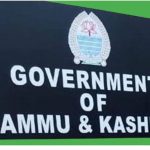Srinagar, May 30: Jammu and Kashmir is the sixth State/UT in the country to have a high prevalence of tobacco use as over 20 percent of the population is indulging in its consumption, officials said.
Dr Mir Mushtaq, State Nodal Officer (Kashmir Division), National Tobacco Control Programme (NTCP), said that in J&K, over 20 percent of the population is indulging in tobacco consumption, which is very high.
As per the National Health Survey, J&K is sixth highest in the country after North Eastern States – Manipur, Arunachal Pradesh, Tripura, Meghalaya and Mizoram – in terms of tobacco consumption.
As per the NHS figures, the prevalence of tobacco in Kashmir includes Kupwara 56 percent, Shopian 52 percent, Anantnag and Bandipora 49 percent, Budgam 48, Pulwama 44, Ganderbal 42, Baramulla and Kulgam 41 percent and Srinagar 38 percent.
Mir said the NTCP program is concerned with enforcement and awareness. “If we make people aware of the ill effects of tobacco, then the enforcement may not be needed because self-consciousness will develop among people,” he said, adding that the main crux of the programme lies with the IEC activities.
“We are generating awareness among people and programmes are held in schools. We also conduct divisional and district level meetings so that tobacco consumption which is highly prevalent is limited,” he said.
The health department is planning activities to be carried out under Tobacco Free Educational Institutions (ToFEI) and Cigarette and Other Tobacco Products Act (COTPA) 2003 in schools across the valley.
“Tobacco control can be achieved by awareness against the use of tobacco and implementation of COTPA and ToFEI around educational institutions,” Mir said.
The Nodal Officer said under COTPA, every school has to appoint a Nodal Officer for tobacco control who can fine shopkeepers and vendors who sell tobacco and tobacco products near schools.
“There is a need for enforcement. Tobacco is putting a huge economic burden on people and it has health hazards associated. Though the prevalence of smoking has decreased, we have seen over the years that the school children have also become habitual of smoking,” he said.
Mir said the role of teachers, schools and the education department is pivotal as the new generation is getting attracted towards smoking which is a challenge.
The Health Department had launched a “yellow line campaign” within a radius of 100 meters from any educational institution to ban the sale of tobacco products.
“As we all know, tobacco is a known health hazard and is responsible for many diseases prevalent in society, particularly various cancers, cardiac diseases and many more,” he said.
The Nodal Officer also said it needs a multi-pronged strategy of different individuals, organisations and departments to coordinate and arrive at a comprehensive policy to defeat this grave issue which is going to have serious consequences if they fail to control it.
As per the figures of NTCP accessed by Rising Kashmir, more than 19,877 challans were conducted in Jammu and Kashmir in the past four years.
According to officials, around 75 percent of cigarettes sale is being sold through loose cigarettes in India and every gazetted officer, according to the COTPA, is authorized to challan the person found smoking in a public place.
Officials also said all the heads of the Health Department were provided challan books and signage for enforcement but there was “no sign of implementation” on the ground.
In 2021, a survey conducted by the Union Health Ministry which had revealed that Kashmir spends a whopping Rs 600 cr on the purchase of tobacco products annually with Srinagar, Anantnag and Baramulla districts topping the numbers.
Jammu and Kashmir is among the states with a huge number of tobacco consumers due to poor enforcement of COTPA. Health officials said the lack of exclusive manpower in districts is a major challenge for the health department in terms of enforcement.
They said although the government had imposed a blanket ban on e-cigarettes and loose cigarettes, the sale of loose cigarettes continues rampantly.
Tobacco use is associated with accelerated mortality among adults, especially in low- and middle-income countries, where the burden of tobacco-related illness and death is heaviest.





